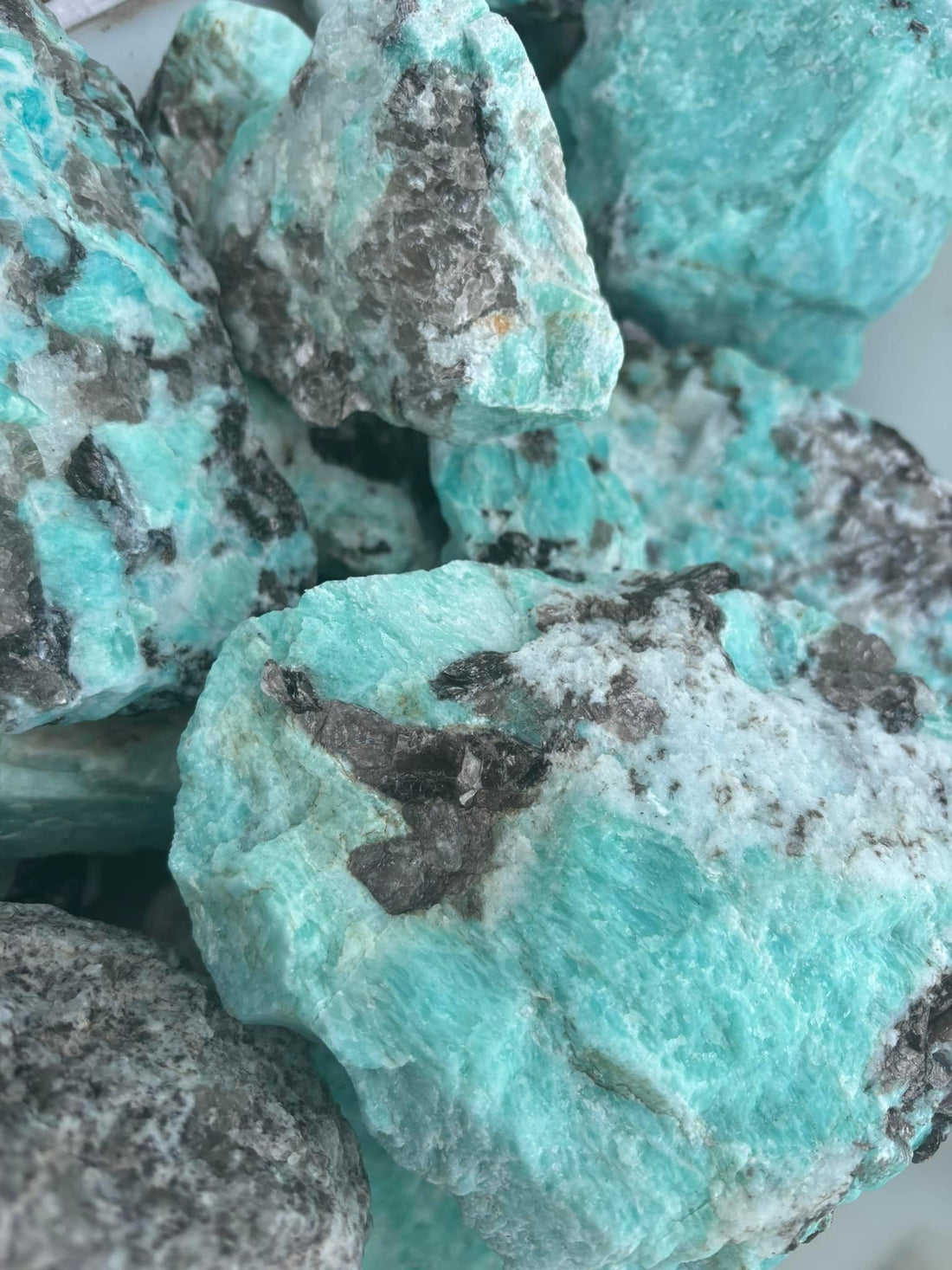
Amazonite: A Comprehensive Overview
Share
Amazonite, also known as amazonstone, is a green tectosilicate mineral, a variety of the potassium feldspar called microcline. The name Amazonite is derived from the Amazon River, although it is uncertain whether the green stones obtained from the river were actually amazonite.
Geological Setting and Occurrence
Amazonite, a stunning green mineral, is found in various geological settings around the globe. It commonly occurs in granitic rocks and pegmatites, environments rich in silica and characterised by coarse-grained textures. In these settings, amazonite is often found alongside other minerals such as quartz, orthoclase, and biotite, contributing to the overall richness and diversity of the geological formations.
Notable occurrences of amazonite include:
-
Australia: Eyre Peninsula, Koppio Amazonite Mine – renowned for high-quality specimens prized by collectors and gem enthusiasts.
-
China: Baishitouquan granite intrusion, Hami Prefecture – associated with well-formed granite formations.
-
Libya: Jabal Eghei, Tibesti Mountains – remote and rugged area hosting amazonite within its granitic formations.
-
Mongolia: Avdar Massif, Töv Province – known for amazonite-bearing pegmatites, offering valuable specimens for study and collection.
-
South Africa: Mogalakwena, Limpopo Province; Ceres Valley, Western Cape – areas rich in mineral diversity with amazonite often associated with other valuable minerals.
-
United States: Colorado, Wyoming, Virginia, Pennsylvania – Colorado's Pikes Peak region and the vicinity of Lake George are particularly famous for producing some of the finest amazonite specimens in the world, often found alongside smoky quartz crystals.
Each location offers a unique geological setting, contributing to the diversity and beauty of amazonite specimens worldwide. From the rich mineral fields of Australia to the rugged mountains of Mongolia, amazonite's global presence highlights the dynamic and varied processes shaping our planet's geology.
Physical and Chemical Properties
Amazonite's chemical formula is KAlSi₃O₈, indicating it is composed of potassium (K), aluminium (Al), silicon (Si), and oxygen (O). This formula represents a specific variety of potassium feldspar known as microcline. Feldspars are a group of rock-forming minerals that make up about 41% of the Earth's continental crust by weight.
The term "polymorphic" refers to the ability of a mineral to exist in more than one form or crystal structure. In the case of amazonite, it is polymorphic with orthoclase. This means that both amazonite and orthoclase have the same chemical composition (KAlSi₃O₈) but differ in their crystal structure.
-
Orthoclase: Monoclinic crystal system, common form of KAlSi₃O₈.
-
Amazonite (Microcline): Triclinic crystal system, green variety of KAlSi₃O₈.
This polymorphism adds to the complexity and fascinating nature of mineralogy, illustrating how variations at the atomic level can lead to diverse and beautiful forms in nature.
Amazonite is characterised by its green to blue-green colour, which is due to the presence of lead and water in its crystal structure. It has a vitreous lustre, a white streak, and a translucent to opaque diaphaneity. The mineral has a hardness of 6.0–6.5 on the Mohs scale and a specific gravity of 2.56–2.58.
Crystallography and Morphology
Amazonite crystallises in the triclinic crystal system, characterised by three axes of unequal length that intersect at oblique angles, making it the least symmetrical of all crystal systems. Amazonite forms prismatic crystals, which are long and column-like, often with well-defined faces.
A key feature of amazonite is its perfect cleavage, meaning it can split smoothly along specific planes. This quality is particularly valuable for gem cutters and mineral collectors, as it allows for the creation of clean, sharp facets in cut stones. However, its cleavage also means that amazonite can be relatively fragile and prone to breaking along these planes.
In terms of fracture, amazonite exhibits an uneven, splintery fracture, which is a common characteristic in minerals that do not break along cleavage planes. This type of fracture results in a rough, jagged surface when the mineral is broken.
The mineral is also described as brittle, which means it tends to break or shatter rather than bend or deform when subjected to stress. This brittleness is a factor to consider when working with amazonite in jewellery or other applications where durability is important.
Amazonite does not show pleochroism, which is the property of displaying different colours when viewed from different angles under polarised light. This absence of pleochroism means that amazonite's colour remains consistent regardless of the viewing angle. Additionally, amazonite does not exhibit significant birefringence, a property where a mineral splits light into two rays, creating a double image. The lack of noticeable birefringence in amazonite further contributes to its visual consistency and appeal.
Applications
Amazonite has been used for jewellery and ornamental purposes for over three thousand years. Archaeological finds in Middle and New Kingdom Egypt and Mesopotamia attest to its ancient use.
Today, amazonite is valued as a gemstone and is occasionally cut and polished for use in jewellery. It is also collected by mineral enthusiasts and used in decorative items.
References:
- en.wikipedia.org
- books.google.com
- si.edu